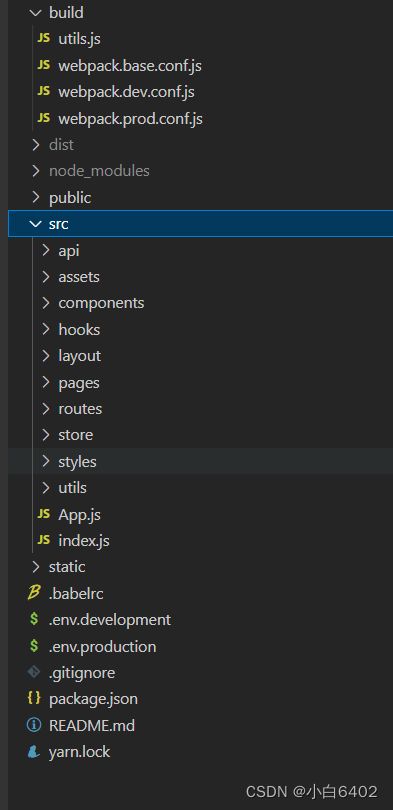浅浅学习复习一下webpack
webpack浅浅学习复习
对于webpack学习,我个人觉得还是自己手动去从零开始搭建框架,然后进行webpack得学习比较好,然后在用于项目内,因为学习得过程中,跟使用得过程中总会不一样得,实际过程中,会遇到各种问题。
这次还是用得是webpack4得,webpack5看了,但都差不多,只是优化算法得改变,和一些属性。在之前作者也曾提过webpack5.0旨在减少配置的复杂度,使其更容易上手(webpack4的时候也说了这句话)
直接看我配置吧,看代码注释就好了,码字太烦了。

对于package.json

utils
const path = require('path') //node自带路径
exports.resolve = (dir) => path.resolve(__dirname, dir) // 相对位置转换绝对位置
exports.assetsPath = (_path) => path.posix.join("static", _path)
webpack.base.conf.js
const utils = require("./utils")
const path = require('path')
const CopyWebpackPlugin = require('copy-webpack-plugin')// 处理static下面的静态文件
const MiniCssExtractPlugin = require("mini-css-extract-plugin"); // css单独文件
const WebpackBar = require('webpackbar'); // 美化webpack控制台输出内容
const isDev = process.env.NODE_ENV === 'development'
module.exports = {
entry: { // 入口
app: ['./src/index.js']
},
output: {// 出口
path: utils.resolve('../dist'),
filename: 'static/js/[name]_[hash:6].js',
publicPath: isDev ? '/' : './', // 打包后资源访问公共路径前缀
chunkFilename: 'static/js/[name].[chunkhash:5].chunk.js',
},
module: {// 模块
rules: [
{
test: /\.(js|jsx|ts|tsx)$/,//一个匹配loaders所处理的文件的拓展名的正则表达式,这里用来匹配js和jsx文件(必须)
exclude: /node_modules/,//屏蔽不需要处理的文件(文件夹)(可选)
use: {
loader: 'babel-loader',
options: { //用babel-loader需要把es6->es5
presets: [
'@babel/preset-env',
['@babel/preset-react', { runtime: "automatic" }], //yarn add @babel/core @babel/preset-react -D
'@babel/preset-typescript'
],
plugins: [
'@babel/plugin-proposal-class-properties',
// '@babel/plugin-syntax-dynamic-import'
]
}
}
},
{
test: /\.css$/,
use: [isDev ? 'style-loader' : {
loader: MiniCssExtractPlugin.loader,
options: {
publicPath: '../../'
}
}
, {
loader: 'css-loader',
options: {
sourceMap: true,
}
},
{
loader: 'postcss-loader',
options: {
postcssOptions: {
plugins: [
require('autoprefixer')
]
}
}
},
]
},
{
test: /\.less$/,
exclude:/\.module\.less$/,
use: [isDev ? 'style-loader' : {
loader: MiniCssExtractPlugin.loader,
options: {
publicPath: '../../' //解决打包图片路径不对
}
},
{
loader: 'css-loader',
},
{
loader: 'postcss-loader',
options: {
postcssOptions: {
plugins: [
require('autoprefixer')
]
}
}
},
{
loader: 'less-loader',
},
]
},
{
test: /\.module\.less$/,
use: [isDev ? 'style-loader' : {
loader: MiniCssExtractPlugin.loader,
options: {
publicPath: '../../'
}
},
{
loader: 'css-loader',
options: {
sourceMap: true,
modules: {
localIdentName: isDev ? '[path]_[name]__[local]_[hash:base64:5]' : '[local]_[hash:base64:5]', // 模块化css修改样式名称
}
}
},
{
loader: 'postcss-loader',
options: {
postcssOptions: {
plugins: [
require('autoprefixer')
]
}
}
},
{
loader: 'less-loader',
options: {
lessOptions: {
module: true
},
sourceMap: true,
}
},
{
loader: 'style-resources-loader',
options: {
patterns: [utils.resolve('../src/styles/index.less')]// 全局样式文件 可以用全局变量样式和mixins等
}
}
]
},
{
test: /\.(png|jpe?g|svg|gif|mp3)$/,
loader: 'url-loader', // 这里是loader 写use要报错
options: {
limit: 10000, // url-loader 包含file-loader,这里不用file-loader, 小于10000B的图片base64的方式引入,大于10000B的图片以路径的方式导入
name: 'static/img/[name].[hash:7].[ext]'
}
},
{
test: /\.(woff2?|eot|ttf|otf)$/,
loader: 'url-loader', // 这里是loader 写use要报错
options: {
limit: 10000, // url-loader 包含file-loader,这里不用file-loader, 小于10000B的图片base64的方式引入,大于10000B的图片以路径的方式导入
name: 'static/fonts/[name].[hash:7].[ext]'
}
},
]
},
resolve: {
extensions: ['.js', '.json', '.jsx', '.ts', '.tsx'], // 解析扩展。(当我们通过路导入文件,找不到改文件时,会尝试加入这些后缀继续寻找文件)
alias: {
'@': path.join(__dirname, '..', "src"), // 在项目中使用@符号代替src路径,导入文件路径更方便
}
},
plugins: [// 插件
new CopyWebpackPlugin([
{
from: utils.resolve('../static'), // 从哪个目录copy
to: ".", // copy到那个目录
}
]),
new MiniCssExtractPlugin({
filename: utils.assetsPath('css/[name]_[hash:7].css'),
chunkFilename: utils.assetsPath('css/[id]_[chunkhash:7].css'),
ignoreOrder: true
}),
new WebpackBar()
],
}
webpack.dev.conf.js
const webpackMerge = require('webpack-merge') // 合并webpack配置
const baseConfig = require('./webpack.base.conf')
const utils = require('./utils')
const HtmlWebpackPlugin = require('html-webpack-plugin') // 解析html
const portfinder = require('portfinder');//自动查找可用端口
const FriendlyErrorsWebpackPlugin = require("friendly-errors-webpack-plugin");//识别某些类的webpack错误,并清除,汇总和优先处理它们
const devWebpackConfig = webpackMerge(baseConfig, {
plugins: [ // 插件
new HtmlWebpackPlugin({
filename: utils.resolve('../dist/index.html'), // html模板的生成路径
template: './public/index.html', // 模板
favicon: "./public/favicon.ico",
inject: true, // true:默认值,script标签位于html文件的 body 底部
}),
],
stats: 'errors-warnings', // 控制台输出内容
devtool: 'inline-source-map',
devServer: {// 开发环境配置
historyApiFallback: true, // 当找不到路径的时候,默认加载index.html文件
hot: true,
contentBase: false, // 告诉服务器从哪里提供内容。只有在你想要提供静态文件时才需要
// compress: true, //一切服务器都用gzip
inline: true,
port: 5500, // 端口
publicPath: '/', // 前缀
open: true, // true,打开默认浏览器
host: "localhost", //设置本地url
overlay: { // 错误全屏显示
errors: true,
warnings: false
},
proxy: {
// // 接口请求代理
// "/api": {
// secure: false,
// target: "http://127.0.0.1:8082"
// }
},
}
})
module.exports = new Promise((resolve, reject) => {
portfinder.basePort = devWebpackConfig.devServer.port;
portfinder.getPort((err, port) => {
if (err) {
reject(err)
} else {
process.env.PORT = port
devWebpackConfig.devServer.port = port
devWebpackConfig.plugins.push(
new FriendlyErrorsWebpackPlugin({
compilationSuccessInfo: {
messages: [
`Your application is running here: http://${devWebpackConfig.devServer.host}:${port}`
],
notes: []
},
clearConsole: true
})
)
resolve(devWebpackConfig)
}
})
})
webpack.prod.conf.js
const HtmlWebpackPlugin = require("html-webpack-plugin") // 解析html文件
const utils = require("./utils") // 导入公共方法
const webpackMerge = require('webpack-merge') // 合并webpack配置
const baseConfig = require('./webpack.base.conf')
const BundleAnalyzerPlugin = require('webpack-bundle-analyzer').BundleAnalyzerPlugin; //打包完成,可视化查看每个文件大小
const { CleanWebpackPlugin } = require('clean-webpack-plugin'); // 每次打包清理文件
const OptimizeCSSAssetsPlugin = require('optimize-css-assets-webpack-plugin'); // 压缩css
const UglifyJsPlugin = require('uglifyjs-webpack-plugin'); // 压缩js
const CompressionWebpackPlugin = require('compression-webpack-plugin')//压缩为gizp
module.exports = webpackMerge(baseConfig, {
plugins: [ // 插件
new HtmlWebpackPlugin({
filename: utils.resolve('../dist/index.html'), // html模板生成路径
template: './public/index.html', // 模板
favicon: "./public/favicon.ico",
inject: true, // true 默认值 script标签位于body底部
hash: true, // 打包资源插入html加上hash
// html文件压缩
minify: {
removeComments: true, // 去除注释
collapseWhitespace: true, // 压缩空间
removeAttributeQuotes: true // 去除属性 标签的 引号 例如 输出
}
}),
new CompressionWebpackPlugin({
asset: '[path].gz[query]',
algorithm: 'gzip',
deleteOriginalAssets: true,
test: /\.(js|css|json|txt|html|ico|svg)(\?.*)?$/i,
deleteOriginalAssets: true,
threshold: 10240,
minRatio: 0.8
}),
new BundleAnalyzerPlugin(),
new CleanWebpackPlugin(),
],
optimization: { // 优化
splitChunks: {
chunks: 'async',//表示哪些代码需要优化,有三个可选值:initial(初始块)、async(按需加载块)、all(全部块),默认为 async
minSize: 30000,//表示在压缩前的最小模块大小
maxSize: 0,
minChunks: 1,//表示被引用次数
maxAsyncRequests: 5,//按需加载时候最大的并行请求数
maxInitialRequests: 3,// 一个入口最大的并行请求数
automaticNameDelimiter: '~',
name: true,
cacheGroups: {//缓存组。缓存组的属性除上面所有属性外
vendors: {
test: /[\\/]node_modules[\\/]/,
priority: -10
},
commons: {
test: /[\\/]node_modules[\\/]/,
name: 'vendors',
chunks: 'all',
},
default: {
minChunks: 2,
priority: -20,
reuseExistingChunk: true
}
}
},
minimizer: [ // 压缩css
new UglifyJsPlugin({
parallel: true, //使用多进程并行运行来提高构建速度
cache: true, // Boolean/String,字符串即是缓存文件存放的路径
uglifyOptions: {
warnings: false,
output: {
comments: false, // 使输出的代码尽可能紧凑
beautify: false // 输出删掉所有注释
},
compress: {
drop_console: true, // 过滤console,即使写了console,线上也不显示
drop_debugger: true,
// warnings:false// UglifyJs版本跟这个没对应上
}
}
}),
new OptimizeCSSAssetsPlugin({
assetNameRegExp: /\.(less)|(css)$/g,
cssProcessor: require('cssnano'), // 用这个压缩过后更小
cssProcessorOptions: {
safe: true,
discardComments: { removeAll: true }, // 移除注释
normalizeUnicode: false // 建议false,否则在使用unicode-range的时候会产生乱码
},
canPrint: true
}),
]
},
})
然后这是我练习得一个demo

通过自己练习比别人讲得要很多,别人讲得再好也是别人得,毕竟笨鸟在于勤于补拙。
参考:掘金
demo地址:github